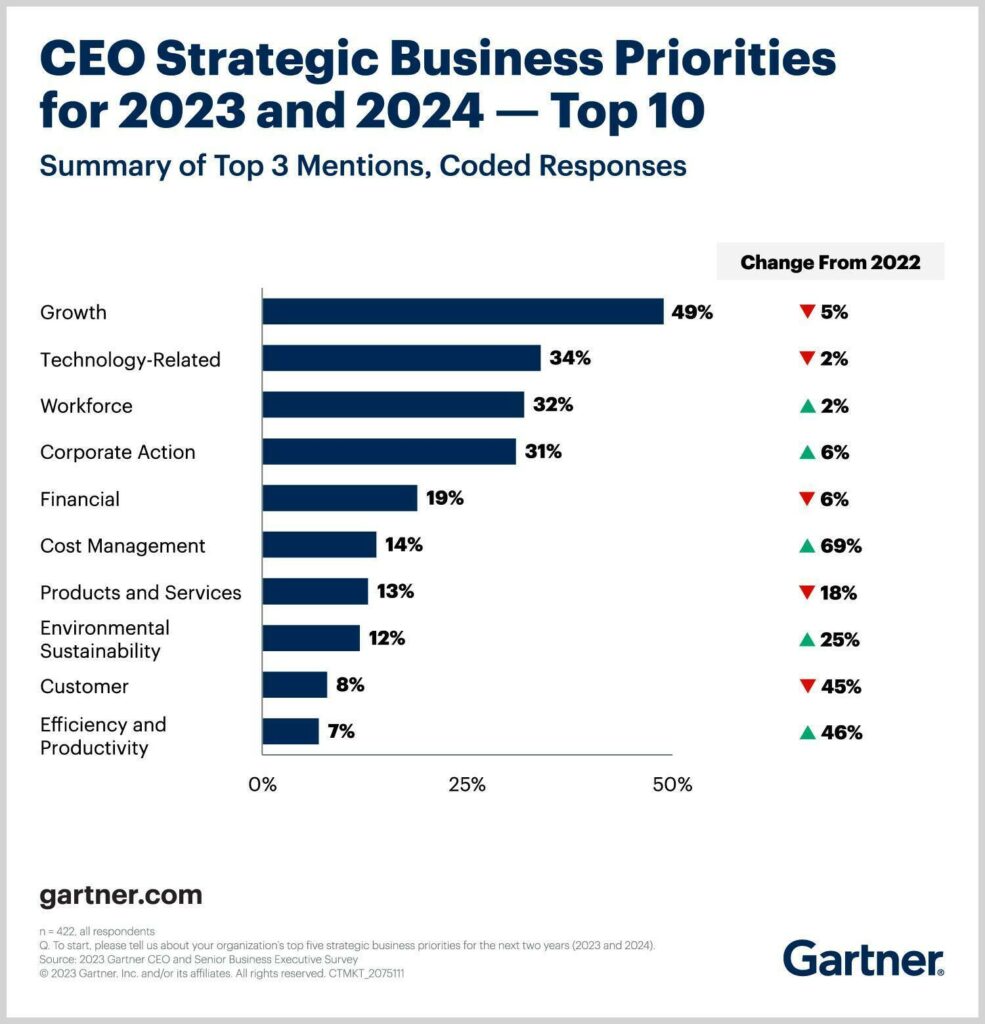Staying Customer-Obsessed after Digital Transformation

In the wake of Digital Transformation, organizations have had to fundamentally change the way they do business and connect with their customers. Organizations that were moving toward digital products and channels, for everything from marketing to CX to product, had to hit the accelerator in 2020.
Spoiler: Don’t worry, we won’t be rehashing 2020!
Rather than linger on the past, let’s look at how brands can stay customer-obsessed in a very
new and ever-changing digital business environment.
This guide answers:
Let’s dive in!
Business has changed in the past 5 years and so have the ways we interact with our customers. More than 65% of customer interactions now happen virtually rather than in-person, up from 25% in 2020 (McKinsey & Company). The interactions between brands and customers occur on apps or websites that have changed and grown dramatically, making these channels more important than ever.
It also affects local governments, non-profits, educational institutions, and any organization that engages with digital audiences. Whether you’re a government agency, a non-profit organization, or an educational institution, digital engagement presents unique hurdles and opportunities.
Unfortunately, many organizations are grappling with…
Many organizations are struggling with poor, declining retention rates, especially for their mobile applications. So far in 2024, the average 30-day mobile app retention rate was only 2.1% for Android apps, and 3.7% for iOS apps (Business of Apps).
These rates can vary from industry to industry, but it’s clear the customer lifecycle for a digital property is short and decreasing. 30-day app retention rates have dropped by 4.4% in 2022 and almost 14% in 2023. (AppsFlyer)
In-app and web-based feedback collection methods have emerged as faster and more direct feedback channels than traditional methods. These newer channels allow for better two-way communications, faster feedback cycles, and an easier time closing the feedback loop.
Digital Transformation has made switching from one brand to another easier than ever. For example, what used to take an in-person visit or a phone call now often just requires a few clicks, deleting one app, and downloading another.
Budget constraints and new business priorities pose a significant challenge to CX teams, as they scramble to stay customer-focused amid business changes.
It’s no secret that budget cuts are forcing many organizations to deprioritize customer experience in 2024. CX and Digital Experience teams certainly feel it, and customers are noticing too. 37% of customers think companies are prioritizing profit over customer experience in 2024. (Accenture)
As budgets tighten, CX and Digital Experience teams face the challenge of remaining customer obsessed. They are tasked with doing more with less, which often leads to compromises in feedback collection, analysis, and follow-up. This strain impacts customer retention by eroding trust and loyalty among customers who have come to expect standout digital experiences.

As you can see in the chart, only 8% of CEOs mentioned the customer in their strategic business priorities in 2023 and 2024. A staggering 45% drop from 2022.
With all due respect to CEOs, there has never been a more important time to prioritize customer obsession and tune into the Voice of the Customer. And that starts with collecting feedback from customers. The data backs this up too, with customer-centric brands reporting profits that were 60 percent higher than brands not focusing on CX. (CX Index)
Customer centric brands reported profits that were 60% higher than brands not focusing on CX.
Thankfully, it’s not all doom and gloom for customer experience teams. New technologies, especially in artificial intelligence, allow teams to analyze feedback and uncover insights faster and more accurately than ever before!

The explosion of new Artificial Intelligence (AI) technologies has impacted almost every job function and department. With the AI cat out of the bag, companies don’t want to be left behind and are quickly acting.
83% of companies listed AI as a top priority in their business plans, and 48% of companies already use AI technology to analyze data effectively. (Exploding Topics)
For Digital Experience Teams, that are already collecting vast quantities of customer feedback either through mobile apps or websites, there is an incredible opportunity to use AI for advanced feedback analytics and insights. The right AI-driven text analysis tool allows CX teams to maximize resources, make smarter business decisions, and bring customer-obsession back into our new business landscape.
Organizations need to adopt new customer communication methods, such as in-app and web-based feedback collection, to stay aligned with evolving customer interaction patterns.
Clearly, the business landscape has changed and is continuing to evolve, so how do different teams stay customer-obsessed?
Tracking customer sentiment is the best way to understand your user experience. Customer sentiment is the kind of metric that allows you monitor how customers feel about your brand, app, or website.
Tracking sentiment doesn’t have to be complicated. Regularly prompting customers with a Yes/No question, “Do you love our company/app/website?” allows you to categorize customers as either Fans or Risks based on their expressed sentiment.
CX teams can then take targeted actions for both sets of customers and learn why customers love your app or brand and why others don’t.
Customers have come to expect personalized digital experiences and mobile is arguably the most personal of any channel. Think about it, we’ve become accustomed to using our mobile devices in a conversational, custom way – and interactions with brands are no different.
Personalizing digital experiences centers on delivering the right message, to the right person, at the right place, at the right time with their experience. That’s quite the mouthful, but it makes sense when you break it down:
Not only do personalized engagements help brands embody customer-obsession, but they significantly increase the amount of time customers spend on your app or website. More time = more revenue opportunities and a higher likelihood of keeping customers around.
CX teams aren’t the only ones being asked to do more with less, product teams are also tasked with delivering high-quality products and experiences with fewer development resources. Guessing what the customer wants and acting on it is not customer-obsessed behavior. So, it is important to let the Voice of the Customer (VoC) drive your roadmap, to not only maximize resources but also be a customer-centric organization. You can collect VoC feedback with traditional surveys, in-app feedback, or on a website. It’s essential that all this feedback is centralized in one accessible location, no matter the channel it came from.
Pro tip: Don’t forget to tie feedback to operational data such as customer value, tenure, and annual recurring revenue (ARR). When feedback is connected to operational data like this, prioritization decisions are much clearer, enabling strategic decision-making and better alignment with business goals.
With VoC feedback in hand, product teams can discover insights that validate or disprove ideas and help prioritize product improvements. Using this feedback to drive your product roadmap mitigates the risk of making assumptions about your customers while rallying the development team around improving customer experience. Don’t forget to tie feedback to operational data
For product teams, implementing a personalized yet scalable approach to closing the feedback loop is crucial. By actively communicating with customers to acknowledge their feedback and demonstrate how it directly influences product improvements, you continue or restore a strong sense of shared ownership and loyalty towards your brand.
In-app Prompts are a great way to close the loop with customers because you can target the exact customers that made the specific feature requests in previous feedback surveys.
In the competitive digital landscape, let’s look at a few brands that exemplify customer obsession through their commitment to creating standout digital experiences and products.

Pilot Flying J, a prominent player in the travel and hospitality sector, faced a critical challenge in understanding and catering to their diverse customer base spread across the United States and Canada.
Traditionally reliant on app store reviews for customer feedback, they recognized a significant gap: reviews often represented extreme opinions rather than the broader sentiments of their customer majority. This lack of direct feedback also meant they couldn’t engage or follow up with customers to address concerns or suggestions.
Recognizing the limitations of app store reviews, Pilot Flying J’s product and CX team leveraged Alchemer Digital to deploy a targeted in-app satisfaction survey. This survey was specifically designed to uncover which features within their app provided the most value to their customers.
This solution drove the following outcomes:

In an industry where customer experience is critical, Pilot Flying J’s customer-obsessed approach solidified their commitment to creating exceptional products and experiences for their most loyal customers.

Dunkin’, a powerhouse in the quick-service restaurant sector, faced a dual challenge of meeting the diverse needs of its franchise owners and loyal customer base. Balancing these demands often slowed down decision-making processes, particularly when it came to updating their mobile app to enhance customer convenience without disrupting operations.
To address these challenges, Dunkin’ utilized Alchemer Digital to collect and analyze customer feedback to gauge customer sentiment and prioritize product improvements.
With Alchemer Digital, Dunkin’ was able to:

With their digital customer feedback strategy, Dunkin’ solidified its reputation as a customer-obsessed brand, committed to improving customer and franchise owner experiences.
Customer obsession isn’t just a buzzword. Customer obsession is a business imperative that directly impacts customer loyalty, retention, and revenue. In today’s budget conscious economy, CX teams must demonstrate tangible outcomes that prove the value of their customer centric initiatives.
At its core, customer obsession aims to foster loyalty by continuously enhancing the customer experience (CX) across all touchpoints. Loyal customers return and advocate for your brand, becoming invaluable brand advocates in competitive marketplaces.
Just last year, we found that brands that were proactive in gauging customer sentiment and collecting customer feedback had a 67% average 30-day retention rate for their mobile apps. This was seven times greater than the industry standard for the same year!
By leveraging customer feedback throughout the development process, CX and Product teams can increase the likelihood that new offerings resonate with their target audience from the start.
This process reduces the risk of spending time and resources on improvements or updates that don’t matter to most customers. By making feedback-driven improvements AND closing the loop with customers who submitted feedback requests, brands can drive higher product adoption on launch.
The ultimate measure of customer obsession lies in its impact on revenue growth. A customer-centric approach drives increased spending per customer and reduces churn, thereby maximizing revenue potential. When brands prioritize understanding and acting on customer feedback, the are likely to cultivate a loyal customer base that not only returns but also advocates for the brand.
Time and time again research and data prove the financial value of customer obsession. One Forrester study found customer-obsessed brands saw 1.8 times more revenue growth and twice the market share growth of their non-customer-obsessed rivals.
Let’s put it all together, in summary:
1. Adapting to Digital Feedback Trends
Organizations must embrace a variety of customer communication methods like in-app and web-based feedback collection to keep pace with changing customer interaction patterns.
2. New Challenges, but also New Opportunities
Many organizations are facing challenges with decreasing retention rates and budget constraints, but there are new opportunities with AI-driven feedback insights and new abilities to personalize customer experiences.
3. Staying Customer-Obsessed in the Digital Era
CX and Product Teams stay customer-obsessed by tracking sentiment, personalizing digital interactions, and using customer feedback to drive product improvements.
4. With Tight Budgets, CX Teams Need to Prove the Value of Customer Obsession
Demonstrating the impact of customer obsession on loyalty, retention, and revenue growth is essential in budget-conscious business world.
Alchemer has decades of experience helping brands turn feedback into action.
Please provide your name and email to continue reading.